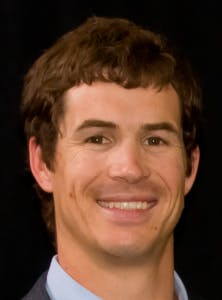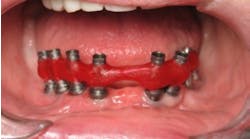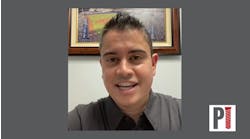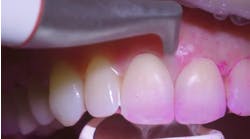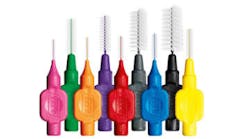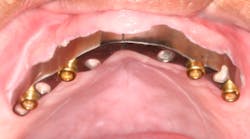Hidden dental dangers of undiagnosed obstructive sleep apnea
Copyright Dreamstime.com
RELATED |Dental sleep medicine: A growing opportunity
Here are a few examples where airway maintenance relates to dentistry:
Prosthodontics/restorative dentistry
Sleep apnea and bruxism have been related through a number of studies. One study demonstrated that “among the associated sleep symptoms and disorders obstructive sleep apnea (OSA) was the highest risk factor for tooth grinding during sleep.” (1) In this same study, patients with OSA were treated with continuous positive airway pressure (CPAP). Treating the OSA also eliminated the tooth grinding.
When treating worn dentition, it important to screen thoroughly for OSA. First, it is important for the patient and the dentist to know why they have destroyed their teeth and that untreated sleep apnea may do the same to their new restorations. More importantly, though, providing a flat-plane occlusal guard may make their sleep apnea worse! In a small study of 10 patients, five of those patients showed an increase in the apnea-hyponea index of 50% when wearing a flat plane splint vs. not wearing anything. (2)This is concerning information which needs more research to confirm.
ADDITIONAL READING |A long journey to finding a good night's sleep
Another patient who may present for extensive restorative treatment is the patient with gastroesophageal reflux disease (GERD). A number of studies show a high prevalence of GERD in patients with OSA. One study estimated 58% to 62% of patients with OSA also had GERD. (3) Moreover, treating GERD with CPAP may decrease the frequency of GERD symptoms. (4) Therefore, in addition to potentially saving the patient’s life by discovering an undiagnosed sleep disorder, screening and awareness of sleep disorders in patients with GERD could provide a solution to the problem and increase the longevity of their dentition.
Periodontics
There is increasing evidence that OSA can result in systemic inflammation. Patients with OSA have a high prevalence of periodontal disease. A recent study showed a 60% of patients diagnosed with periodontitis had OSA.(5) Since periodontitis is an inflammatory disease, OSA may increase the risk for periodontal disease by increasing inflammation in the body. (6) Interestingly enough, treatment of OSA with CPAP improves levels of inflammatory markers.(7) This is particularly interesting considering atherosclerosis is an inflammatory disease. OSA may be the link between atherosclerosis and periodontal disease that the dental community has been so interested in since the association between these two conditions was demonstrated. Hopefully a study will be forthcoming that assesses the affect of treating OSA on periodontal disease!
Pediatric dentistry/orthodontics
In dental school, I was taught that the outward force of the tongue and the inward forces of the facial muscles guide arch development. When a patient has chronic nasal obstruction and is forced to breathe through his or her mouth, the tongue ceases to be a force for expansion of the arch. The result is a crowded arch, increased facial height, and potentially the distal displacement of the condyle along with retrusion of the mandible. (8) Some of the patients will have sleep apnea as children, but will also have an increased risk of sleep apnea as adults due to retrognathia that can result from mouth breathing.
The most common and effective treatment is removal of the tonsils and/or adenoid tissue where the airway obstruction is occurring by an ENT. When that does not work or is contraindicated, orthodontic expansion of the arch is an alternative or may be used concurrently and is quite successful. (9) Still, for some kids CPAP is necessary, but the constant pressure of a mask strapped to the face can have serious side effects of restricting the growth and development of the maxilla. For children with nasal obstruction and not sleep apnea, referral to the allergist for environmental or food sensitivities may be indicated.
Dentists are in prime position to recognize the symptoms of mouth breathing and sleep apnea in children. Maintaining a patent nasal airway throughout development encourages full-arch development and reduces the risk for crowding, TMD, and sleep apnea in the future.
Temporomandibular joint dysfunction
Many patients in a dental practice may present with temporomandibular joint dysfunction that is brought on by the side effects of sleep apnea. Bruxism has been discussed and, in addition to oxygen deprivation, can lead to headaches and muscle pain. Sleep apnea can also deprive patients of their REM sleep. Loss of REM sleep can lead to increased pain levels, including the TM joints and muscles of mastication. (10)
Also, when treating TMD, it important to screen meticulously for signs and symptoms of OSA. A cohort and case control study both “supported a significant association of OSA symptoms and TMD.” (11) Treating the OSA may help alleviate the TMD symptoms, but it may not. As with anything in dentistry, the more information presented to the patient before treatment, the more the patient begins to understand and take ownership of their condition.
Surgical procedures/implant placement
Patients with OSA can be hyperalgesic, as mentioned above. Therefore, expect more discomfort during the procedure and afterwards. OSA patients also have more inflammatory markers and therefore higher inflammation levels. Expect longer and more difficult healing. The increased inflammatory load is also interesting when considering implant placement and success. I could not find any studies discussing implant failure and sleep apnea, but it could be possible that a patient with untreated sleep apnea (and a higher inflammatory load in their body) would have a higher failure risk. Again, this area needs more research, but is interesting to consider.
Understanding the human body’s need for airway maintenance and the effects of sleep related breathing disorders provides the general practitioner with a more complete perspective in almost all facets of general dentistry. General dentists are in a unique position to screen for these disorders and make the appropriate referrals. This helps bridge the gap between medicine and dentistry and provides a more complete level of care for patients.
References
1. Oksenberg A, Aarons E. Reduction of sleep bruxism using a mandibular advancement device: an experimental controlled study. Sleep Med. Nov. 2002; 3(6):513-515.
2. Mayer P, Morisson F, Rompré PH, Lavigne GJ. Aggravation of repiratory disturbances by the use of an occlusal splint in apneic patients. Int J Prosthodont. Jul.-Aug. 2004;17(4):447-453.
3. Jung H, Choung RS, Talley NJ. Gastroesophageal reflux disease and sleep disorders: evidence for a causal link and therapeutic implications. J Neurogastroenterol Motil. January 2010;16(1):22-29.
4. Green BT, Broughton WA, O'Connor JB. Marked improvement in nocturnal gastroesophageal reflux in a large cohort of patients with obstructive sleep apnea treated with continuous positive airway pressure. Arch Intern Med. Jan 13, 2003;163(1):41-45.
5. Seo WH, Cho ER, Thomas RJ, An SY, Ryu JJ, Kim H, Shin C. The association between periodontitis and obstructive sleep apnea: a preliminary study. J Periodontal Res. Aug. 2013;48(4):500-506. doi: 10.1111/jre.12032. Epub Nov 30, 2012.
6. Gunaratnam K, Taylor B, Curtis B, Cistulli P. Obstructive sleep apnoea and periodontitis: a novel association? Sleep Breath. Aug. 2009;13(3):233-239. doi: 10.1007/s11325-008-0244-0. Epub Feb. 6, 2009.
7. Baessler A, Nadeem R, Harvey M, Madbouly E, Younus A, Sajid H, Naseem J, Asif A, Bawaadam H. Treatment for sleep apnea by continuous positive airway pressure improves levels of inflammatory markers - a meta-analysis. Journal of Inflammation 2013;10:13.
8. Harari D, Redlich M, Miri S, Hamud T, Gross M. The effect of mouth breathing versus nasal breathing on dentofacial and craniofacial development in orthodontic patients. Laryngoscope. Oct. 2010;120(10):2089-2093. doi: 10.1002/lary.20991.
9. Villa MP, Rizzoli A, Miano S, Malagola C. Efficacy of rapid maxillary expansion in children with obstructive sleep apnea syndrome: 36 months of follow-up. Sleep Breath. May 2011;15(2):179-84. doi: 10.1007/s11325-011-0505-1. Epub Mar. 25, 2011.
10. Roehrs T, Hyde M, Blaisdell M, Greenwald M, Roth T. Sleep loss and REM sleep loss are hyperalgesic. SLEEP 2006;29(2).
11. Sanders AE, Essick GK, Fillingim R, Knott C, Ohrbach R, Greenspan JD, Diatchenko L, Maixner W, Dubner R, Bair E, Miller VE, Slade GD. Sleep apnea symptoms and risk of temporomandibular disorder: OPPERA cohort. J Dent Res. Jul. 2013;92(7 Suppl):70S-7S. doi: 10.1177/0022034513488140. Epub May 20, 2013.


